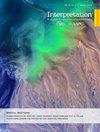Challenges and Best Practices in Interpreting Cross-well Strain Signals to Monitor Multi-Crew Zipper Fracturing Operations
IF 1.1
4区 地球科学
Q3 GEOCHEMISTRY & GEOPHYSICS
Interpretation-A Journal of Subsurface Characterization
Pub Date : 2023-03-01
DOI:10.1190/int-2022-0092.1
引用次数: 0
Abstract
Cross-well strain measurements using Low-frequency Distributed Acoustic Sensing (LF-DAS) is an emerging technique to monitor hydraulic fracture propagation. The qualitative interpretations of the strain rate data have been used to evaluate the fracturing stimulation efficiency, hydraulic fracture geometry, and cross-well communication. Limited studies have investigated the cross-well strain signals recorded from offset fibers during zipper fracturing treatment, though zipper fracturing becomes a routine method of stimulating horizontal wells in unconventional reservoirs. This gap will be filled in this research by presenting the methods we developed to investigate complicated LF-DAS signals. These approaches were further demonstrated using field datasets recorded along the two temporal sensing fiber cables during the zipper fracturing operation of seven offset wells with two fracking crews operating simultaneously. By exploring, comparing, and presenting the LF-DAS data recorded in wireline and disposable fiber cables, this research shares the best practices for visualizing and interpreting cross-well strain signals. The LF-DAS dataset shown in this study, which, to the best of our knowledge, is one of the most complicated LF-DAS datasets presented. The approaches proposed here can be extended and applied to visualize and interpret different kinds of complicated LF-DAS signals recorded using permanent, wireline, and disposable fiber cables.解释井间应变信号以监控多人拉链压裂作业的挑战和最佳实践
利用低频分布式声学传感(LF-DAS)进行井间应变测量是一种新兴的监测水力裂缝扩展的技术。应变速率数据的定性解释已用于评估压裂增产效率、水力裂缝几何形状和井间通信。尽管拉链压裂已成为非常规储层中刺激水平井的常规方法,但有限的研究对拉链压裂处理过程中偏移纤维记录的井间应变信号进行了研究。这一空白将在本研究中通过介绍我们开发的研究复杂LF-DAS信号的方法来填补。在两名压裂人员同时作业的七口偏移井的拉链式压裂作业期间,使用沿两条时间传感光纤电缆记录的现场数据集进一步证明了这些方法。通过探索、比较和展示电缆和一次性光纤电缆中记录的LF-DAS数据,本研究分享了可视化和解释井间应变信号的最佳实践。据我们所知,本研究中显示的LF-DAS数据集是最复杂的LF-DAS数据集之一。本文提出的方法可以扩展并应用于可视化和解释使用永久、有线和一次性光纤电缆记录的不同类型的复杂LF-DAS信号。
本文章由计算机程序翻译,如有差异,请以英文原文为准。
求助全文
约1分钟内获得全文
求助全文
来源期刊

Interpretation-A Journal of Subsurface Characterization
GEOCHEMISTRY & GEOPHYSICS-
CiteScore
2.50
自引率
8.30%
发文量
126
期刊介绍:
***Jointly published by the American Association of Petroleum Geologists (AAPG) and the Society of Exploration Geophysicists (SEG)***
Interpretation is a new, peer-reviewed journal for advancing the practice of subsurface interpretation.
 求助内容:
求助内容: 应助结果提醒方式:
应助结果提醒方式:


